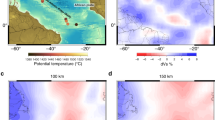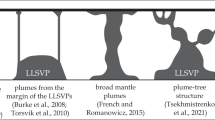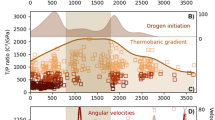Abstract
Hotspots that form above upwelling plumes of hot material from the deep mantle typically leave narrow trails of volcanic seamounts as a tectonic plate moves over their location. These seamount trails are excellent recorders of Earth’s deep processes and allow us to untangle ancient mantle plume motions. During ascent it is likely that mantle plumes are pushed away from their vertical upwelling trajectories by mantle convection forces. It has been proposed that a large-scale lateral displacement, termed the mantle wind, existed in the Pacific between about 80 and 50 million years ago, and shifted the Hawaiian mantle plume southwards by about 15° of latitude. Here we use 40Ar/39Ar age dating and palaeomagnetic inclination data from four seamounts associated with the Louisville hotspot in the South Pacific Ocean to show that this hotspot has been relatively stable in terms of its location. Specifically, the Louisville hotspot—the southern hemisphere counterpart of Hawai’i—has remained within 3–5° of its present-day latitude of about 51° S between 70 and 50 million years ago. Although we cannot exclude a more significant southward motion before that time, we suggest that the Louisville and Hawaiian hotspots are moving independently, and not as part of a large-scale mantle wind in the Pacific.
This is a preview of subscription content, access via your institution
Access options
Subscribe to this journal
Receive 12 print issues and online access
$259.00 per year
only $21.58 per issue
Buy this article
- Purchase on Springer Link
- Instant access to full article PDF
Prices may be subject to local taxes which are calculated during checkout





Similar content being viewed by others
Change history
21 December 2012
Nature Geoscience 5, 911–917 (2012); published online 25 November 2012. In the print version of this Article originally published, the present address for Toshitsugu Yamazaki was erroneously omitted. It is as follows: Atmosphere and Ocean Research Institute, The University of Tokyo, 5-1-5 Kashiwanoha, Kashiwa, Chiba 277-8564, Japan.
References
Koppers, A. A. P. & Watts, A. B. Intraplate seamounts as a window into deep earth processes. Oceanography 23, 42–57 (2010).
Wilson, J. T. A possible origin of the Hawaiian Islands. Can. J. Phys. 41, 863–870 (1963).
Morgan, W. J. Convection plumes in the lower mantle. Nature 230, 42–43 (1971).
Wessel, P. & Kroenke, L. W. Pacific absolute plate motion since 145 Ma: An assessment of the fixed hot spot hypothesis. J. Geophys. Res. 113, B06101 (2008).
Tarduno, J. A. et al. The Emperor Seamounts: Southward motion of the Hawaiian hotspot plume in earth’s mantle. Science 301, 1064–1069 (2003).
Tarduno, J., Bunge, H-P., Sleep, N. & Hansen, U. The bent Hawaiian-emperor hotspot track: Inheriting the mantle wind. Science 324, 50–53 (2009).
Expedition 330 Scientists Louisville Seamount Trail: Implications for Geodynamic Mantle Flow Models and the Geochemical Evolution of Primary Hotspots IODP Preliminary Report, vol. 330, 174, http://dx.doi.org/10.2204/iodp.pr.330.2011 (2011).
Wessel, P., Harada, Y. & Kroenke, L. Toward a self-consistent, high-resolution absolute plate motion model for the Pacific. Geochem. Geophys. Geosyst. 7, Q03L12 (2006).
Courtillot, V., Davaille, A., Besse, J. & Stock, J. Three distinct types of hotspots in the Earth’s mantle. Earth Planet. Sci. Lett. 205, 295–308 (2003).
Steinberger, B., Sutherland, R. & O’Connell, R. J. Prediction of Emperor-Hawaii seamount locations from a revised model of global plate motion and mantle flow. Nature 430, 167–173 (2004).
Koppers, A. A. P., Duncan, R. A. & Steinberger, B. Implications of a non-linear 40Ar/39Ar age progression along the Louisville seamount trail for models of fixed and moving hotspots. Geochem. Geophys. Geosyst. 5, Q06L02 (2004).
Steinberger, B. & Antretter, M. Conduit diameter and buoyant rising speed of mantle plumes: Implications for the motion of hot spots and shape of plume conduits. Geochem. Geophys. Geosyst. 7, Q11018 (2006).
Steinberger, B. & Calderwood, A. R. Models of large-scale viscous flow in the Earth’s mantle with constraints from mineral physics and surface observations. Geophys. J. Int. 167, 1461–1481 (2006).
Koppers, A. A. P. et al. New 40Ar/39Ar age progression for the Louisville hotspot trail and implications for inter-hotspot motion. Geochem. Geophys. Geosyst. 12, Q0AM02 (2011).
Watts, A. B., Weissel, J. K., Duncan, R. A. & Larson, R. L. Origin of the Louisville Ridge and its relationship to the eltanin fracture zone system. J. Geophys. Res. 93, 3051–3077 (1988).
Antretter, M., Riisager, P., Hall, S., Zhao, X. & Steinberger, B. in Origin and Evolution of the Ontong Java Plateau, Vol. 229 (eds Fitton, G., Mahoney, J., Wallace, P. & Saunders, A.) 21–30 (The Geological Society, 2004).
Parker, R. L. & Gee, J. S. Calibration of the pass-through magnetometer—II. Application. Geophys. J. Int. 150, 140–152 (2002).
Kono, M. in Initial reports of the Deep Sea Drilling Project, Leg 55, Honolulu, Hawaii to Yokohama, Japan, July–September 1977 Vol. 55 (eds Jackson, E. D. & Koisumi, I. et al.) 737–752 (US Government Printing Office, 1980).
Tarduno, J. A. & Cottrell, R. D. Paleomagnetic evidence for motion of the Hawaiian hotspot during formation of the Emperor seamounts. Earth Planet. Sci. Lett. 153, 171–180 (1997).
Arason, P. & Levi, S. Maximum likelihood solution for inclination-only data in paleomagnetism. Geophys. J. Int. 182, 753–771 (2010).
Wessel, P. & Kroenke, L. W. Observations of geometry and ages constrain relative motion of Hawaii and Louisville plumes. Earth Planet. Sci. Lett. 284, 467–472 (2009).
Constable, C. G. & Johnson, C. L. Anisotropic paleosecular variation models: Implications for geomagnetic field observables. Phys. Earth Planet. Int. 115, 35–51 (1999).
Tauxe, L. & Kent, D. V. in Geophysical Monograph Series 145: Timescales of the Internal Geomagnetic Field (eds Channell, J. E. T., Kent, D. V., Lowrie, W. & Meert, J. G.) 101–115 (American Geophysical Union, 2004).
Mcfadden, P. L., Merrill, R. T., Mcelhinny, M. W. & Lee, S. H. Reversals of the Earths Magnetic-Field and Temporal Variations of the Dynamo Families. J. Geophys. Res. 96, 3923–3933 (1991).
Lonsdale, P. Geography and history of the Louisville hotspot chain in the southwest pacific. J. Geophys. Res. 93, 3078–3104 (1988).
Smith, W. H. F. & Sandwell, D. Predicted bathymetry. New global seafloor topography from satellite altimetry. Eos. Trans. AGU 77–46, 315 (1996).
Acknowledgements
This research used samples and data provided by the IODP. Financial support was provided by the NSF and IODP-USSSP. We thank J. Huard, S. Schnur and D. Heaton for support in the OSU Argon Geochronology Laboratory. The JOIDES Resolution captain, crew and technicians are thanked for their support during IODP Expedition 330. We also thank C. Constable and L. Tauxe for providing code for the geomagnetic field models and P. Arason for the inclination-only averaging code.
Author information
Authors and Affiliations
Contributions
All authors contributed extensively to the work presented in this paper. A.A.P.K., T.Y. and J.G. led and supervised IODP Expedition 330. A.A.P.K. carried out the 40Ar/39Ar geochronology analyses. J.S.G. carried out the bootstrap analysis and Kolmogorov–Smirnov statistical tests. J.S.G., N.P. and H.H. were the shipboard palaeomagnetists collecting the inclination measurements. N.P. was responsible for additional post-cruise data quality control. A.A.P.K. and J.S.G. wrote the main paper and the Supplementary Information. All authors co-edited this manuscript. The IODP Expedition 330 Scientific Party includes all other shipboard scientists responsible for core descriptions, igneous petrology and volcanology, geochemistry, palaeontology, sedimentology, downhole logging and physical properties.
Corresponding authors
Ethics declarations
Competing interests
The authors declare no competing financial interests.
Supplementary information
Supplementary Information
Supplementary Information (PDF 1068 kb)
Supplementary Information
Supplementary Information (PDF 1289 kb)
Rights and permissions
About this article
Cite this article
Koppers, A., Yamazaki, T., Geldmacher, J. et al. Limited latitudinal mantle plume motion for the Louisville hotspot. Nature Geosci 5, 911–917 (2012). https://doi.org/10.1038/ngeo1638
Received:
Accepted:
Published:
Issue Date:
DOI: https://doi.org/10.1038/ngeo1638
This article is cited by
-
Progress in the numerical modeling of mantle plumes
Science China Earth Sciences (2023)
-
Thermochemical anomalies in the upper mantle control Gakkel Ridge accretion
Nature Communications (2021)
-
Mantle plumes and their role in Earth processes
Nature Reviews Earth & Environment (2021)
-
Hotspot motion caused the Hawaiian-Emperor Bend and LLSVPs are not fixed
Nature Communications (2019)
-
Superplume mantle tracked isotopically the length of Africa from the Indian Ocean to the Red Sea
Nature Communications (2019)



